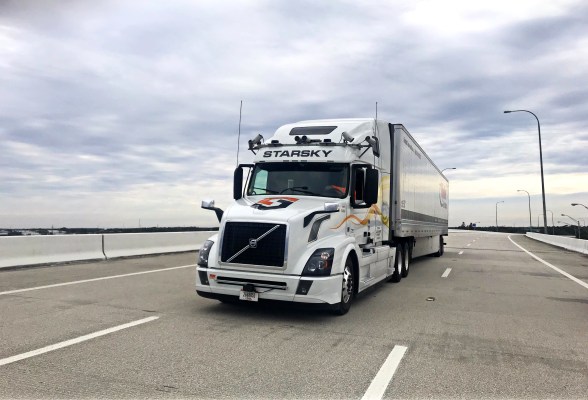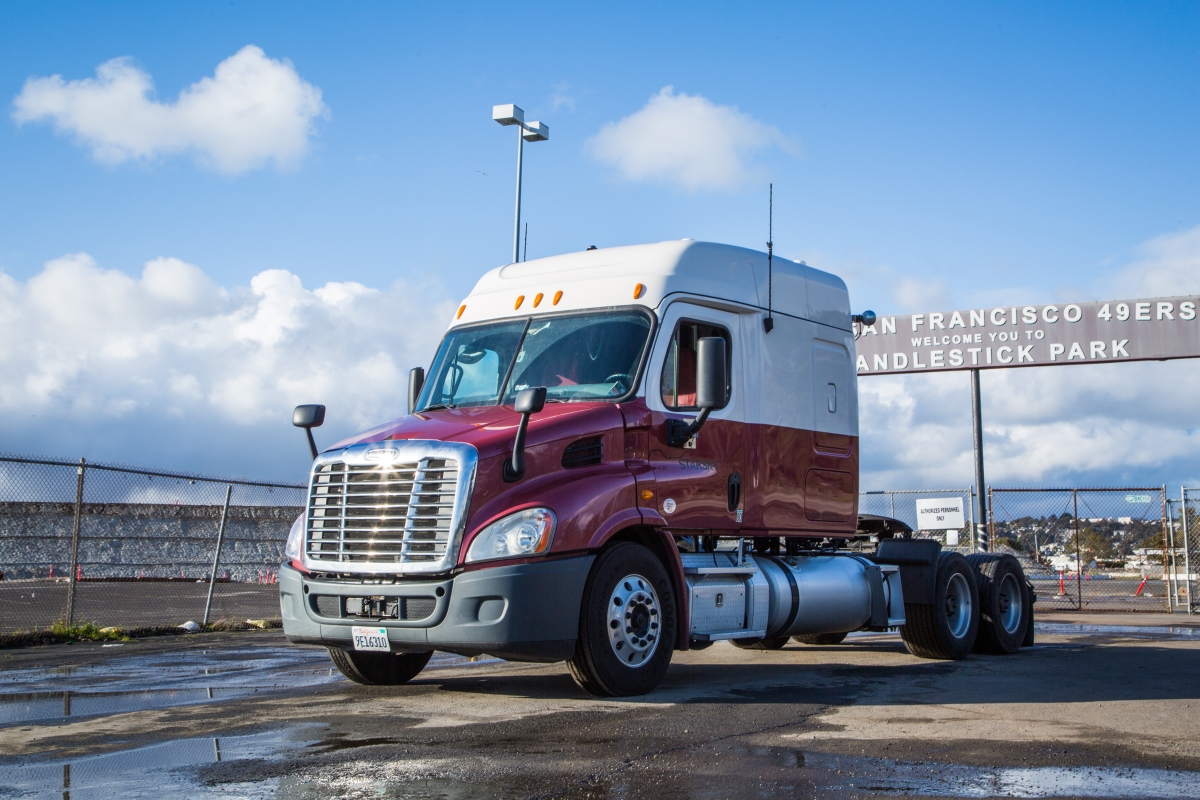More than three years ago, self-driving trucks startup Starsky Robotics was founded to solve a fundamental issue with freight — a solution that CEO Stefan Seltz-Axmacher believes hinges on getting the human driver out from behind the wheel.
But a funny thing happened along the way. Starsky Robotics started a regular ol’ trucking company. Now, nearly half of the employees at this self-driving truck startup help run a business that uses the traditional model of employing human drivers to haul loads for customers, TechCrunch has learned.
Starsky’s trucking business, which has been operating in secret for nearly two years alongside the company’s more public pursuit of developing autonomous vehicle technology, has hauled 2,200 loads for customers. The company has 36 regular trucks that only use human drivers to haul freight. It has three autonomous trucks that are driven and supported by a handful of test drivers. Starsky also employs a number of office people who, as Seltz-Axmacher notes, “know how to run trucks.”
The CEO and co-founder contends that without the human-driven trucking piece, Starsky won’t ever have an operational, or profitable, self-driving truck business. The trucking business has generated revenue, led to key partnerships such as Schneider Logistics, Penske Truck Leasing and Transport Enterprise Leasing, and importantly, helped build a company that works in the real world. It has also been a critical tool for recruiting and vetting safety drivers and teleoperators (or remote drivers), according to Seltz-Axmacher.
“The decision to have a trucking business interact with the real trucking world in parallel with developing the robotics piece is a necessary part of building a longstanding business in the space,” said Reilly Brennan, general partner at Trucks VC and the first institutional investor in Starsky.
Starksy, which was co-founded by Seltz-Axmacher and Kartik Tiwari, has raised $21.7 million in equity from investors including Shasta Ventures and Trucks VC.
The evolution over at Starsky illustrates the challenge that awaits the autonomous vehicle industry and the giant companies and startups operating within it. Even after engineers solve the complexity of building an AI-powered driver that’s better than a human, these companies must figure out the equally intricate task of operations. Robotaxis, autonomous delivery robots and self-driving trucks won’t matter if humans don’t use, like or trust the tech.
Figuring out the basics of operations — including the rather pedestrian and obvious ones — will mean the difference between making or losing money. Or, having a business at all.
And the stakes are high. Trucks are the backbone of the U.S. economy and moved more than 70% of all U.S. freight and generated more than $700 billion in 2017, according to the most up-to-date statistics available from the American Trucking Associations (ATA).
Companies pursuing robotaxis and other autonomous vehicle programs are going to eventually wake up — if they haven’t already — to the same realities that Starsky has accepted, Brennan contends.
“The interaction with the market, particularly in logistics, is vital,” Brennan said, adding that companies pursuing robotaxis that haven’t built out and tested a consumer-facing app risk the same problems. “They need to have a business on day one, not on day 720.”
For Starsky, it started with something as basic as having a working vehicle and access to mechanics that could fix it.
Trucks, the hard way
Seltz-Axmacher admits now he underestimated how difficult trucks could be.
“Hey, it’s a truck, how hard can buying one be?,” said Seltz-Axmacher, as he described the company’s first major purchase of a truck for about $50,000. “We quickly realized that having a truck and driving a truck are not easy things to do.”
Starsky engineers retrofitted the truck, named Rosebud, with its autonomous driving system and made plans to test it at the Thunderhill Raceway about 150 miles north of San Francisco. It didn’t make it. The truck’s engine was smoking by the time it crossed the Bay Bridge. And then the truck, along with all those engineers, sat for two weeks while Seltz-Axmacher hunted for a diesel mechanic.
The truck, pictured above, continued to break down. The company ran into more snafus, including a problem with insurance and the title of the vehicle. Starsky was going to miss a key milestone and Seltz-Axmacher was going to have to tell investors that it wasn’t because of bottlenecks in engineering, but because they didn’t know how to manage the truck part of this self-driving truck company.
The founders learned that even “average” trucks needed to go to the shop every 60 days, which is operationally complex when vehicles are traveling throughout the United States.
Starsky ended up making a key hire, Paul Schlegel, who is a veteran of trucking operations, to organize the enterprise. Schlegel, who has 32 years in the transportation industry with companies such as Schneider National and Stevens Transport, developed the trucking business that enabled autonomous trucks, but still worked in their absence. The trucking operations team is in Dallas.
The driver pinchpoint
Seltz-Axmacher has said repeatedly that “unless you’re getting the driver out of the truck, you’re not solving anything.”
The problem in trucking is the supply of drivers. The chronic shortage has, in turn, driven up costs. For instance, the median salary for a truckload driver working a national, irregular route was more than $53,000 — a $7,000 increase from ATA’s last survey, which covered annual pay for 2013, or an increase of 15%. It’s even higher for private fleet drivers, who saw their pay rise to more than $86,000 from $73,000, or a gain of nearly 18%.
Starksy soon found that finding the right drivers was just as hard as finding the right trucks. The Federal Motor Carrier Safety Administration shows the company has reported three crashes of its manually driven trucks.
Seltz-Axmacher said they’ve had a driver make a wrong turn and have a low-hanging branch rip a hole in the side of a trailer. The most serious incident involved a new driver who took an offramp in Florida too fast and rolled the truck onto its side. No one was injured and the driver was terminated.
These drivers are critical to the autonomous program and the best of them end up becoming teleop controllers, a job that involves sitting in an office, not logging days and weeks in a truck.
Starsky is taking a dual approach to its autonomous trucks. It outfits regular trucks with a combination of sensors like radar and cameras along with software that allows long-haul trucks to drive autonomously on the highway. When the truck is about to exit, a trained remote operator, who is sitting in an office, takes over and navigates the truck to its final destination.
The promise of being able to be promoted to teleoperator is a big part of how Starsky is able to hire drivers effectively. The company contends it wouldn’t be possible to find 25 highly skilled safety and remote drivers without having a broader fleet of regular truck drivers to choose from.
Robotrucks or bust
The ultimate goal of Starsky Robotics hasn’t changed, Seltz-Axmacher said. To get there, the company recently hired Ain McKendrick as vice president of engineering, and former Tesla executive Keith Flynn to head up its hardware manufacturing to support Starsky’s fleet build. McKendrick, who co-founded Podtek and Lyve, also has experience at autonomous vehicle company Cyngn, Highfive, Netflix and Dell.
By early 2020, the company aims to have 25 autonomous trucks — a goal that is only possible if it has 100 regular trucks, he added.
The only way Starsky can scale its operations on the autonomous side is to continue to scale its regular trucking operations six months in advance. In other words, the regular trucking business is inextricably linked to the success of deploying autonomous trucks.
The company has already found that the 15-plus brokers that are regularly giving it freight to haul are ready for driverless trucks.
“Many times the brokers who have given us loads have been fairly ambivalent to whether or not we’re hauling that freight with a self-driving truck, Seltz-Axmacher said. “A lot of the concern that people might have is that this is a technology-averse industry and might not be willing to accept self-driving trucks has proven not to be true.”

